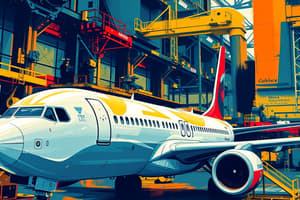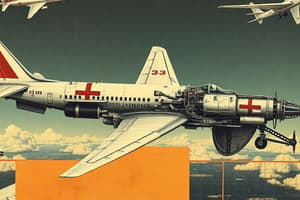Podcast
Questions and Answers
What are Dr. Soler's research interests related to in the context of Air Traffic Management?
What are Dr. Soler's research interests related to in the context of Air Traffic Management?
Optimal control with application to green trajectory planning for commercial aircraft.
Which notable award did Dr. Soler receive in 2013?
Which notable award did Dr. Soler receive in 2013?
The SESAR young scientist award.
Identify two types of aerospace vehicles mentioned in the content.
Identify two types of aerospace vehicles mentioned in the content.
Fixed wing aircraft and rotorcraft.
What is the purpose of the SESAR initiative in aviation research?
What is the purpose of the SESAR initiative in aviation research?
What part of an aircraft is described as the main structure that houses passengers and cargo?
What part of an aircraft is described as the main structure that houses passengers and cargo?
Name one of the challenges mentioned in the aviation research agenda.
Name one of the challenges mentioned in the aviation research agenda.
What role do control surfaces play on an aircraft?
What role do control surfaces play on an aircraft?
In terms of propulsion, what is a vital component of aircraft mentioned in the content?
In terms of propulsion, what is a vital component of aircraft mentioned in the content?
What are the three main parts of the book 'Fundamentals of Aerospace Engineering'?
What are the three main parts of the book 'Fundamentals of Aerospace Engineering'?
What topics are covered under 'The Aircraft' section of the book?
What topics are covered under 'The Aircraft' section of the book?
Who is the author of the book 'Fundamentals of Aerospace Engineering'?
Who is the author of the book 'Fundamentals of Aerospace Engineering'?
What type of license does the book 'Fundamentals of Aerospace Engineering' operate under?
What type of license does the book 'Fundamentals of Aerospace Engineering' operate under?
Where can the electronic version of the book be accessed?
Where can the electronic version of the book be accessed?
What is the primary aim of the book 'Fundamentals of Aerospace Engineering'?
What is the primary aim of the book 'Fundamentals of Aerospace Engineering'?
What must users do to share the book according to its Creative Commons license?
What must users do to share the book according to its Creative Commons license?
What kind of content does the 'Introduction' section discuss?
What kind of content does the 'Introduction' section discuss?
What are the primary loads experienced by an aircraft fuselage during flight?
What are the primary loads experienced by an aircraft fuselage during flight?
What is the function of the wing in an aircraft?
What is the function of the wing in an aircraft?
How does the hydraulic system contribute to aircraft safety?
How does the hydraulic system contribute to aircraft safety?
What role does the combustion chamber play in a jet engine?
What role does the combustion chamber play in a jet engine?
Identify two critical requirements for aircraft instruments.
Identify two critical requirements for aircraft instruments.
What is the significance of Fly-By-Wire systems in modern aircraft?
What is the significance of Fly-By-Wire systems in modern aircraft?
Explain the importance of the landing gear in an aircraft.
Explain the importance of the landing gear in an aircraft.
What is the function of the propeller in aircraft propulsion?
What is the function of the propeller in aircraft propulsion?
What is the significance of the angle of attack in airfoil performance?
What is the significance of the angle of attack in airfoil performance?
How does induced drag relate to lift in an airfoil?
How does induced drag relate to lift in an airfoil?
Explain the concept of supercritical airfoils and their advantage.
Explain the concept of supercritical airfoils and their advantage.
Describe the role of high-lift devices in aircraft performance.
Describe the role of high-lift devices in aircraft performance.
What is the divergence Mach number and its significance in aerodynamics?
What is the divergence Mach number and its significance in aerodynamics?
How do pressure distributions relate to lift on an airfoil?
How do pressure distributions relate to lift on an airfoil?
What factors affect the coefficient of lift along the wingspan of an airfoil?
What factors affect the coefficient of lift along the wingspan of an airfoil?
Define normal stress and its relevance to airfoil structures.
Define normal stress and its relevance to airfoil structures.
What is the primary focus of aerospace engineering?
What is the primary focus of aerospace engineering?
List two sectors involved in aerospace activities as mentioned in the overview.
List two sectors involved in aerospace activities as mentioned in the overview.
According to the content, which aspect is considered key for the future of aviation?
According to the content, which aspect is considered key for the future of aviation?
Define engineering based on the paragraph provided.
Define engineering based on the paragraph provided.
What is the significance of the Clean Sky initiative in aviation research?
What is the significance of the Clean Sky initiative in aviation research?
Summarize the term 'taxonomies of capabilities' in the context of aerospace engineering.
Summarize the term 'taxonomies of capabilities' in the context of aerospace engineering.
Explain the role of research institutions in the aerospace sector.
Explain the role of research institutions in the aerospace sector.
Why is a broad overview important for students entering aerospace engineering?
Why is a broad overview important for students entering aerospace engineering?
What significant change occurred in the airline industry due to the 1978 United States Deregulation Act?
What significant change occurred in the airline industry due to the 1978 United States Deregulation Act?
How did traditional airlines adapt to the rise of low-cost companies in recent years?
How did traditional airlines adapt to the rise of low-cost companies in recent years?
What term is used to describe state-owned airlines that had strategic influence in the aviation sector?
What term is used to describe state-owned airlines that had strategic influence in the aviation sector?
In what ways have military air forces influenced technology and innovation?
In what ways have military air forces influenced technology and innovation?
What is the primary focus of military air forces in contemporary contexts?
What is the primary focus of military air forces in contemporary contexts?
What has been the impact of low-cost airlines on mass transportation of people?
What has been the impact of low-cost airlines on mass transportation of people?
What are some of the direct operating costs issues that might differentiate low-cost airlines from traditional airlines?
What are some of the direct operating costs issues that might differentiate low-cost airlines from traditional airlines?
Describe the strategic role of military air forces in relation to the economic potential of a country.
Describe the strategic role of military air forces in relation to the economic potential of a country.
Flashcards
Aircraft parts
Aircraft parts
Components of an aircraft, including the fuselage, wings, empennage, control surfaces, and propulsion system.
Fixed-wing aircraft
Fixed-wing aircraft
A type of aircraft that generates lift with fixed wings.
Rotorcraft
Rotorcraft
An aircraft that gets lift from rotating blades.
Air Traffic Management (ATM)
Air Traffic Management (ATM)
Signup and view all the flashcards
Green Trajectory Planning
Green Trajectory Planning
Signup and view all the flashcards
Optimal control
Optimal control
Signup and view all the flashcards
Commercial aircraft
Commercial aircraft
Signup and view all the flashcards
SESAR
SESAR
Signup and view all the flashcards
Aerospace Engineering
Aerospace Engineering
Signup and view all the flashcards
Introductory Course
Introductory Course
Signup and view all the flashcards
Aeronautical Engineering
Aeronautical Engineering
Signup and view all the flashcards
Undergraduate Course
Undergraduate Course
Signup and view all the flashcards
Fundamentals of Aerospace Engineering
Fundamentals of Aerospace Engineering
Signup and view all the flashcards
Creative Commons License
Creative Commons License
Signup and view all the flashcards
Free distribution
Free distribution
Signup and view all the flashcards
Non-commercial use
Non-commercial use
Signup and view all the flashcards
Aircraft Materials
Aircraft Materials
Signup and view all the flashcards
Aircraft Loads
Aircraft Loads
Signup and view all the flashcards
Electrical System
Electrical System
Signup and view all the flashcards
Fuel System
Fuel System
Signup and view all the flashcards
Aircraft Instruments
Aircraft Instruments
Signup and view all the flashcards
Propeller Function
Propeller Function
Signup and view all the flashcards
Jet Engine Inlet
Jet Engine Inlet
Signup and view all the flashcards
Jet Engine Compressor
Jet Engine Compressor
Signup and view all the flashcards
Boundary layer transition
Boundary layer transition
Signup and view all the flashcards
Effects of the speed of sound in airfoils
Effects of the speed of sound in airfoils
Signup and view all the flashcards
Aerodynamic forces and moments
Aerodynamic forces and moments
Signup and view all the flashcards
Lift generation
Lift generation
Signup and view all the flashcards
Induced drag
Induced drag
Signup and view all the flashcards
High-lift devices
High-lift devices
Signup and view all the flashcards
Normal stress
Normal stress
Signup and view all the flashcards
Coefficient of lift along a wingspan
Coefficient of lift along a wingspan
Signup and view all the flashcards
Flag companies
Flag companies
Signup and view all the flashcards
What is engineering?
What is engineering?
Signup and view all the flashcards
What does an aerospace engineer do?
What does an aerospace engineer do?
Signup and view all the flashcards
Deregulation Act of 1978
Deregulation Act of 1978
Signup and view all the flashcards
What are the major aerospace activities?
What are the major aerospace activities?
Signup and view all the flashcards
Low-cost airlines
Low-cost airlines
Signup and view all the flashcards
What is the Clean Sky program?
What is the Clean Sky program?
Signup and view all the flashcards
Direct operating costs
Direct operating costs
Signup and view all the flashcards
What is SESAR?
What is SESAR?
Signup and view all the flashcards
Military air forces
Military air forces
Signup and view all the flashcards
Why is research crucial in aviation?
Why is research crucial in aviation?
Signup and view all the flashcards
Military air forces' strategic role
Military air forces' strategic role
Signup and view all the flashcards
What are some challenges in aviation?
What are some challenges in aviation?
Signup and view all the flashcards
Technology and innovation in military air forces
Technology and innovation in military air forces
Signup and view all the flashcards
Cooperation and alliances in military air forces
Cooperation and alliances in military air forces
Signup and view all the flashcards
What is the scope of aerospace engineering?
What is the scope of aerospace engineering?
Signup and view all the flashcards
Study Notes
Dr. Soler's Research Interests
- Dr. Soler's research interests are focused on Air Traffic Management (ATM).
Dr. Soler's Award
- Dr. Soler received the prestigious NASA Exceptional Achievement Medal in 2013 for his work on the Next Generation Air Transportation System (NextGen).
Aerospace Vehicles
- Aircraft are a primary focus of aerospace engineering.
- Spacecraft, designed for space exploration, are another type of aerospace vehicle.
SESAR Initiative
- The Single European Sky ATM Research (SESAR) initiative is a European research program focused on improving air traffic management efficiency and safety.
Aircraft Structure
- The fuselage, the main body of an aircraft, houses passengers and cargo.
Challenges in Aviation Research
- One challenge is reducing fuel consumption and improving aerodynamic efficiency.
Role of Control Surfaces
- Control surfaces (e.g., ailerons, elevators, rudders) adjust the aircraft's orientation and control its flight path.
Vital Propulsion Component
- Jet engines are crucial for aircraft propulsion, enabling them to generate thrust.
Book: Fundamentals of Aerospace Engineering
- The book is divided into three main parts:
- Introduction to Aerospace Engineering
- The Aircraft
- Aerodynamics
Content of 'The Aircraft' Section
- This section covers the structure and functions of different aircraft components, including the fuselage, wings, tail, landing gear, and powerplant.
Book Author
- Anderson, John D. is the author of "Fundamentals of Aerospace Engineering."
Book License
- The book operates under a Creative Commons Attribution-NonCommercial-ShareAlike 4.0 International License.
Book Accessibility
- The electronic version of "Fundamentals of Aerospace Engineering" can be accessed online at [link to access]
Book's Primary Aim
- The book aims to provide a comprehensive understanding of fundamental aerospace engineering principles.
Sharing the Book
- To share the book, users must attribute the original author and distribute the work under a similar license.
Introduction Section Content
- The Introduction section discusses the origins, history, and evolution of aerospace engineering.
Aircraft Fuselage Loads
- The aircraft fuselage experiences primary loads during flight, including:
- Shear forces
- Bending moments
- Torsional moments
Wing's Function
- The wing is designed to generate lift, allowing the aircraft to overcome gravity and stay airborne.
Hydraulic System Contribution
- The hydraulic system plays a vital role in maintaining aircraft safety by:
- Controlling flight surfaces
- Operating brakes
- Deploying landing gear
Combustion Chamber Role
- The combustion chamber within a jet engine mixes fuel with air, producing hot, expanding gas that generates thrust.
Aircraft Instruments Requirements
- Critical requirements for aircraft instruments include:
- Accuracy
- Reliability
Fly-By-Wire System Significance
- Fly-By-Wire systems in modern aircraft allow:
- Electronic control of flight surfaces
- Enhanced stability and responsiveness.
Landing Gear Importance
- The landing gear facilitates the process of takeoff and landing by providing a stable connection between the aircraft and the runway.
Propeller Function
- The propeller, used in propeller-driven aircraft, rotates, pushing air and generating thrust to propel the aircraft forward.
Angle of Attack Importance
- The angle of attack, the angle between the airfoil's chord line and the oncoming airflow, significantly impacts airfoil performance.
Induced Drag and Lift Relationship
- Induced drag is a form of drag generated due to the creation of lift by a wing. It is directly related to the amount of lift produced.
Supercritical Airfoils
- Supercritical airfoils are designed to minimize wave drag at high speeds. They feature a curved upper surface and a flattened lower surface.
High-Lift Devices
- High-lift devices (e.g., flaps, slats) are employed during takeoff and landing to increase lift and decrease landing speed.
Divergence Mach Number
- The divergence Mach number is the speed at which the flow over an airfoil starts to become supersonic. It is significant because it marks the onset of compressibility effects.
Pressure Distributions and Lift
- The distribution of pressure along the upper and lower surfaces of an airfoil creates a pressure difference which generates lift.
Lift Coefficient Factors
- Factors affecting the coefficient of lift along the wingspan of an airfoil:
- Wing shape
- Angle of attack
- Airflow speed
Normal Stress
- Normal stress is the force acting perpendicular to a surface, crucial for understanding the strength and integrity of airfoil structures.
Aerospace Engineering Focus
- Aerospace engineering focuses on the design, development, and operation of aerospace systems.
Aerospace Sectors
- Aerospace activities encompass two major sectors:
- Aviation
- Space
Future of Aviation
- Sustainability is crucial for the future of aviation, with a focus on reducing environmental impact.
Engineering Definition
- Engineering is the application of scientific knowledge to solve practical problems and create useful systems.
Clean Sky Importance
- The Clean Sky initiative aims to reduce the environmental impact of aviation by developing innovative technologies for cleaner, more sustainable aircraft.
Taxonomy of Capabilities
- Taxonomies of capabilities involve categorizing and characterizing the different skills and knowledge needed in aerospace engineering.
Research Institutions' Role
- Research institutions play a vital role in driving innovation, conducting fundamental research, and developing new technologies for the aerospace sector.
Broad Overview Importance
- A broad overview of aerospace engineering is essential for students to understand the scope and diversity of the field, guiding their future career choices.
Airline Industry Change
- The 1978 United States Airline Deregulation Act brought about significant changes in competition by removing price controls and restrictions on routes for airlines.
Traditional Airlines Adapting
- Traditional airlines have adapted to the rise of low-cost companies by offering similar cost-effective travel options and adopting leaner business models.
State-Owned Airlines
- State-owned airlines are often described as flag carriers, signifying their national importance.
Military Air Forces Influence
- Military air forces have historically driven technological advancements in aviation, leading to innovations in materials, engines, and aircraft design.
Military Air Forces Focus
- The primary focus of contemporary military air forces is on maintaining national security and strategic deterrence.
Low-Cost Airline Impact
- Low-cost airlines have significantly impacted mass transportation by making air travel more accessible to a broader population.
Low-Cost Airline Costs
- Direct operating costs (e.g., fuel, crew) are often managed more efficiently by low-cost airlines compared to budget-conscious airlines.
Military Air Forces Strategic Role
- Military air forces play a critical role in a country's economic potential by ensuring national security and facilitating the flow of goods and services.
Studying That Suits You
Use AI to generate personalized quizzes and flashcards to suit your learning preferences.




